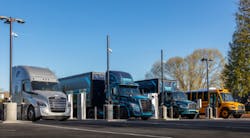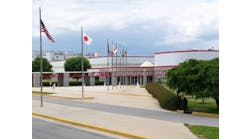Leading the Charge: OEMs Are Investing in Electric Trucks
Truck manufacturers - including Daimler Trucks North America (DTNA) - are making significant investments in electric truck development.
MTD recently caught up with Alex Voets, product sales and marketing manager for DTNA’s Freightliner brand, to discuss Daimler’s electric truck offerings in North America. The company's first all-electric products, the eCascadia and the Freightliner eM2, are now available for order. Production of the trucks will start next year.
Voets also discusses investments that are being made in the electric truck charging infrastructure. DTNA recently opened what it calls a “first-of-its-kind, heavy-duty electric truck charging site” across the street from its corporate headquarters in Portland, Ore. (Click here to read MTD's recent article about how electric trucks could impact commercial tire design.)
MTD: Can you bring us up to speed on the evolution of DTNA’s electric truck program. What’s the latest?
Voets: We currently have 38 (electric) trucks in early customer trials. One, the Freightliner Electric Innovation Fleet, includes a 30-vehicle fleet dedicated to our two customers, NFI Industries and Penske.
Penske has 10 medium-duty eM2s and both companies have 10 heavy-duty eCascadias each. In addition, we have the Freightliner Customer Experience (CX) Fleet, which includes six eCascadias and two eM2s. Both fleets see our trucks performing real work in the real world in a variety of applications - 750,000 miles and counting.
MTD: What feedback have you heard from fleets?
Voets: Feedback has been great. Uptime has been well-appreciated, as has simplicity of use. Drivers love the smoothness of the powertrain and ability to maintain gaps in traffic, thanks to the incredible torque and regenerative braking and lack of noise/vibration/harshness in ride quality.
Of course, everyone would like greater range to allow more operational time, but these trucks are largely charging overnight. (Editor’s note: The eCascadia has a range of 250 miles per charge. Eighty-percent of the truck’s battery can be recharged within a 90-minute period, according to DTNA.)
MTD: What is DTNA’s strategy for helping ensure that a sufficient number of charging stations are in place?
Voets: Right now, our targeted applications are those that have a return-to-base operation. Drayage, local delivery and pick-up and regional delivery are all great applications that see trucks domiciled at a central location, where they can be recharged overnight.
With our customers participating in the Freightliner Electric Innovation and CX fleets, we've helped coordinate the installation of chargers at those depots by coordinating with customer and utility companies.
We anticipate this depot charging dynamic being the focus of the foreseeable future and that dispersed charging to enable longer routes will take some greater time, as the cost to install those stations, the supply lines to reach them and the resiliency of the grid will all be hurdles that need to be cooperatively addressed by OEMs, electric vehicle supply equipment manufacturers, utilities and local, state and federal governments.




